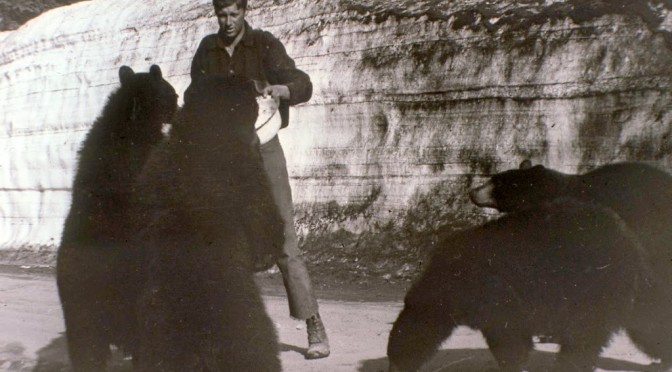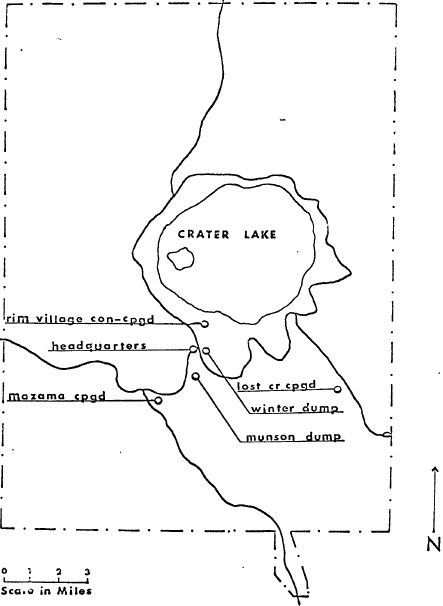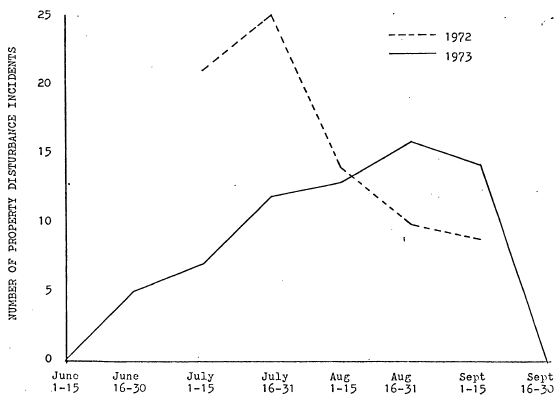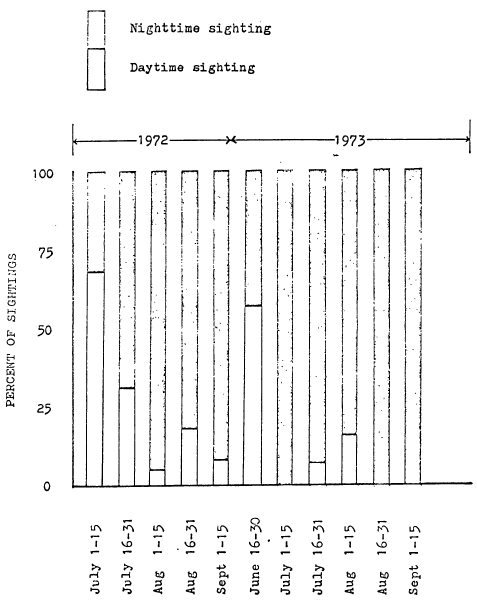Research and Management of Black Bears in Crater Lake National Park, Oregon, 1974
INTRODUCTION
National Park Service Progress Report, RSP CRLA-N-2A
January 20, 1974
Prepared by Michael R. McCollum
Black bears (Ursus americanus) and grizzly bears (Ursus arctos) once inhabited Crater Lake National Park and the surrounding area. The last known grizzly in the region was killed-near Fort Klamath in 1894 or 1895 (Merriam 1897). Although there are conflicting opinions concerning the early abundance of black bears in the region (Merriam 1897 and Herrero 1969), black bears have been common in the park since its establishment in 1902.
During the last 50 years black bears have concentrated at garbage dumps within Crater Lake National Park. Bears habituated to garbage at the dumps have become nuisances in the campgrounds. With a loss of respect for humans by bears and vice versa, human injury and property damage has occurred.
Where bears are concerned there is a difference of opinion as to the manner in which garbage pits should be eliminated. One view is to quickly stop dumping forcing bears to natural feeds immediately. The other view proposes to reduce dumping gradually and phase out dumps “weaning” bears off garbage. This controversy has developed from management of grizzly bears in Yellowstone National Park and has been debated at length (Cole 1971; Cole 1973; Craighead & Craighead 1971; National Wildlife Federation 1973). At Crater Lake the former approach of quickly eliminating dumping was implemented. However, black bears rather than grizzlies were the subject of study and numbers of nuisance bears and dump closures were of a much lower magnitude than that reported for Yellowstone.
During the late 1930’s the major garbage dump, located near the present headquarters, was relocated at the head of Munson Valley. Over the years the Munson Dump was established as an area of abnormally high bear concentrations. An observation of 42 bears was made at the dump in 1939 (Walters 1953), and 40 bears were in view at one time in and around the dump in 1941 (Dixon 1944). As recently as 1969, 22 bears were identified using the Munson Dump (Herrero 1969).
Following the recommendations of Dixon (1944) and Herrero (1969) the Park Service eliminated all dumping within Crater Lake National Park. The Munson Dump was closed in October 1971 and use of a smaller winter dump located near headquarters was discontinued the same year.
The present study was originated in anticipation of possible incidents with habitual garbage bears when they emerged from hibernation in the spring of 1972. The study was designed to show changes in feeding habits and tendencies toward property damage because of dump closures. Information pertinent to the future management of bears within the park was also sought.
I would like to express my sincere appreciation for the help and encouragement offered by Park Service employees and numerous other individuals during the course of study. I am indebted to John Chitwood who helped familiarize me with radio equipment and helped in the construction of antennas. Much of the scat analysis was done by Humboldt State College student Dennis Knuckles.
OBJECTIVES
Before objectives of the current study can be outlined, management goals should be identified. As a primary goal of wildlife management within the parks, the Advisory Board on Wildlife Management recommends, “…that the biotic associations
within each park be maintained…as nearly as possible in the condition that prevailed when the area was first visited by the white man…” (Leopold 1963). Bear management goals reported for Yellowstone National Park by the Natural Sciences Advisory Committee of the National Park Service include: (1) to maintain populations of grizzly and black bears at levels that are sustainable under natural conditions as part of the native fauna of the park, (2) to plan development and use of the park so as to minimize conflicts and unpleasant or dangerous incidents with bears, and (3) to encourage bears to lead their natural lives with minimum interference by humans (Leopold et al. 1969).
As they pertain to the black bear, these goals are representative of the long range management objectives sought at Crater Lake. Considering these goals and the situation at Crater Lake, the following study objectives were proposed: (1) determine the reactions of bears to the closure of garbage dumps within the park, (2) determine which bears are nuisance or dangerous bears, (3) determine the best way of handling nuisance bears and revert to a wild population, (4) obtain an estimate of total bear numbers in the park, (5) provide information on numbers of park bears which may be harvested by hunters on adjacent lands, and the effects of hunting on the park bear population, and (6) provide general information on the life history, population dynamics, and ecology of black bears in and near the park. Study objectives were expanded during 1973 to: (7) determine habitat utilization by black bears and identify the importance and seasonal use of different vegetative types, (8) determine seasonal and diel movements of black bears, and (9) determine the size and shape of black bear home ranges.
THE STUDY AREA
Geology And Topography
Crater Lake National Park, including an area of approximately 250 square miles, is situated in the Cascade Range of southern Oregon. Elevations range from 3,977 feet in the southwest corner of the park to 8,926 feet at the highest point. The geologic history of the region has been described by Baldwin (1964).
Developments
Nearly one-half million visitors pass through Crater Lake National Park annually. Major developments and visitor accommodations include three campgrounds, the Rim Village concession facilities, and the park headquarters including employee residences. Mazama, Rim, and Lost Creek Campgrounds provide 198, 54, and 12 campsites respectively. Locations of highways, developments, and closed dumpsites are shown in Figure 1. Approximately 72 percent of the park is backcountry or wilderness area.
Climate
Nearly all winter precipitation occurs in the form of snow. Snowfall, rainfall, and temperature vary significantly with changes in elevation. At an elevation of 6,475 feet annual snowfall averages over 575 inches. Approximately 70 percent of the annual precipitation falls during the five months of November through March.
Summer daytime temperatures range in the 70’s and seldom exceed 85 degrees Fahrenheit. Nightly summer temperatures average between 40 and 50 F. During the winter months daytime temperatures range slightly above freezing with nightly averages of 17 to 20 F.
Vegetation
The area is characterized by its dense coniferous forest, small dry pumice flats, and moist openings in the forest. More than a dozen species of coniferous trees are represented in the park. The few species of broad-leaf trees are sparsely distributed as understory plants in the open forests. A thorough treatment of the floral composition of Crater Lake National Park is presented by Applegate (1939). The three life zones found within the park include the Transition, Canadian, and Hudsonian.
METHODS
Data concerning black bear activity were obtained from observations reported by park personnel and tourists, park files, field notes, and studies of marked and radio equipped bears. Bears were captured with culvert-type live traps, Aldrich foot snares, and by the immobilization of froe-roaming and treed bears.
Live traps were set using the methods of Erickson (1957). Cubby sets similar to those described by Jonkel and Cowan (1971) were used for foot snares. Live traps were set at the Munson dumpsite and at problem bear areas. Foot snares were generally used in more remote areas or when bears became trap-shy. Baits used included salmon and deer carcasses, meat scraps, canned cat food, sardines, apples, honey, and table scraps.
Attempts were made to immobilize free-roaming bears when they came into campgrounds or other developed areas. These bears could usually be approached to within 20 to 40 feet and darted with an immobilizing agent. If not spooked or chased, bears seldom traveled more than 50 to 75 yards before complete ataxis. Bears were captured in this manner during both night and daytime.
Immobilizing drugs were administered with a projectile syringe fired by a carbon dioxide-powered long range projector (Cap-Chur gun, Palmer Chemical Co., Inc., Douglasville, Georgia). Phencyclidine hydrochloride ( Sernylan, Bio-Ceutic Laboratories, Inc., St. Joseph Missouri) was administered intramuscularly at dosages ranging from 0.5 to 2.0 mg per pound of body weight. Limited use was made of” Etorphine and its antagonist Diprenorphine (X99 and M50-50, American Cyanamid Co., Princeton, New Jersey. An intramuscular injection of penicillin (Durbiotic, Burn Pharmaceuticals, Oakland, California) was administered to bears handled during 1973.
Immobilized bears were weighed, measured, and examined to determine their general physical condition and reproductive status. Bears were then ear tagged with a metal tag (Perfect Ear Tags, Salt Lake Stamp Co., Salt Lake City, Utah) supplied by the Oregon Game Commission- All tags, except number 1, had the phrase “RET ORE GAME COMM” stamped on the back. In addition to tagging, most bears were tattooed inside the lower lip.
Transplants were limited to the park and surrounding portions of the Cascade Mountain Range. All bears involved in the trap-and-transfer studies were nuisance animals. In this report, “nuisance” bears are distinguished from “wild” bears in that the former were captured in, or known to frequent, developed areas. Bears classified as wild were captured at wilderness sites and were not known to frequent developed areas.
Radio transmitters were attached by collar to several bears to obtain data on movements and home range size. Receiver and transmitters (Electronics Unlimited, Sacramento, California) operated between 31.38 and 31.56 MHz. Initial contact with instrumented bears was made by driving available roads and using the’ receiver connected to a 102 inch whip antenna. When a good signal was heard a directional antenna constructed of television cable and attached to a collapsible 15 foot beam was set up. The bear’s location was triangulated by taking directional bearings from several locations. In several cases, locations triangulated in this manner were verified by walking in with hand-held tracking equipment., Locations determined from triangulation were generally within one-eighth mile of the bears actual position. The range of both the whip and the directional antenna was two to four miles, provided the antenna was in line of sight with the transmitter.
Food habit data were determined from the collection and analysis of bear scats. The majority of scats were collected near developed areas and all collections were within the Hudsonian Life Zone. When possible, scats were aged to the nearest 15 day period. Scat analysis was accomplished by modifying the point frame technique described by Chamrad and Box (1964) for sampling rumen contents. A thorough explanation of equipment used and procedures followed is given by Knuckles (1972).
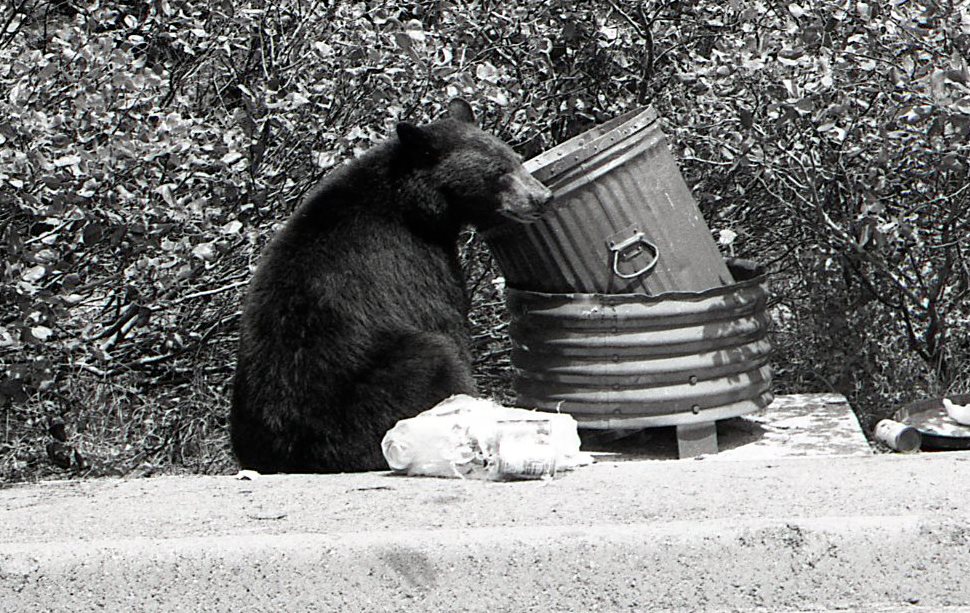
BEAR-HUMAN RELATIONSHIPS
Pre Dump Closure Activity
A summary of bear management activities at Crater Lake for 1964 through 1973 are presented in Table 1. All bear incidents involving injury or property disturbance are routinely recorded by park personnel. Property disturbance incidents include cases where property is damaged and incidents where a lunch was disturbed, a garbage can tipped over, etc., but no real damage was done. Prior to dump closures (1971) total incidents were relatively constant except for 1969 when there were 56 incidents (Table 1). Examination of park files indicates that only one or two bears were responsible for this increase. A sow and two cubs, which were finally killed, accounted for at least one injury and many of the property disturbance incidents. Thus, it appears that bear problems prior to dump closures remained at a fairly stable level with an occasional increase due to the persistent actions of a few bears.
| Table 1. Bear management activities for Crater Lake National Park, 1964-1973. |
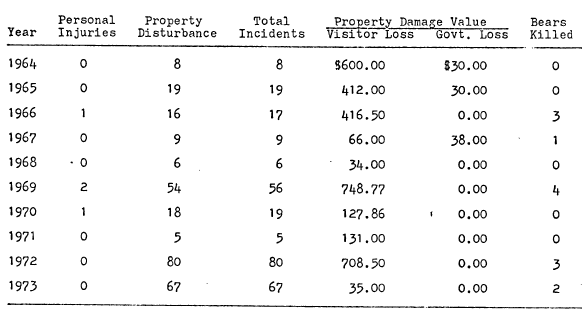 |
Control by killing nuisance bears has been sporadic and dependent upon the various management philosophies of each new administration. Bears destroyed between 1964 to 1971 were primarily in response to bear inflicted injuries. A standard practice during this same time period was to trap and transfer nuisance bears to distant locations within the park. Until 1972-73 nuisance bears were not marked nor was the success of the transfer program evaluated.
Post Dump Closure Activity
Bear visitation to developed areas increased sharply following dump closures. Total property disturbance incidents increased from 5 in 1971 to 80 in 1972 (Table 1). Property disturbance incidents remained at a relatively high level during 1973, although seriousness of the problem decreased markedly and was reflected by a 74 percent decrease in property damage incidents for that year. The number of identified nuisance bears decreased from 14 in 1972 to 5 in 1973. Without harassment received by bears through study operations total incidents would undoubtedly have been even greater during both years.
Locations of bear sightings are reported for 1972-73 in Table 2. During the spring of 1972 bears confined their nuisance activities to the headquarters area, less than one and one-half miles from the closed Munson dumpsite. As the 1972 season progressed problem areas became more widespread. The headquarters area yielded the majority of bear sightings during 1973, primarily due to the persistent actions of one bear. Of 23 property damage incidents during 1972-73, 16 were reported from Mazama Campground. Despite the lack of bearproof garbage containers, no incidents were reported from the Lost Creek Campground. This is the smallest of the park’s three campgrounds and is the furthest from the Munson dumpsite (Fig. l). The percent of bear observations in wilderness areas increased from about three percent of the total sightings in 1972 to about 9 percent of the 1973 sightings.
| Table 2. Locations of black bear sightings at Crater Lake National Park, 1972-73. |
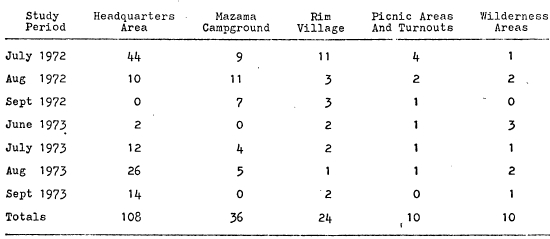 |
Numbers of property disturbance incidents peaked one month later in 1973 than in 1972 (Fig. 2). The 1973 curve corresponds closely with the usual pattern of park visitation; visitor numbers increase from a low level in June, peak during August, and drop off sharply after mid-September. An intensive trap-transfer program, mortalities, harassment to bears, and decreasing visitation all probably contributed to the decline in property disturbance incidents following July, 1972.
There were differences in the time of bear observations during the 1972-73 seasons (Fig. 3). Early in the season the majority of observations were made during daylight hours. From August through mid-September few bears were seen except at night. This trend to a more nocturnal habit was partly due to the decreased amount of human activity at night combined with an increase in food availability, ie. garbage cans are generally fullest in the evening, campgrounds are filled, and foodstuffs are unattended. Disturbance from daytime capture and tagging operations also caused bears to become more wary and nocturnal as the summer progressed.
Garbage Disposal
Reasons for bear visitation to developed areas are obvious. Adequate preparations for garbage collection and storage were not completed prior to the dump closures. This resulted in bears merely switching their garbage eating locations from the dumps to developed areas.
The roadside beggar, a prominent figure in other national parks, is almost nonexistent at Crater Lake. The major problem stems from inadequate handling of garbage and food storage problems in the campgrounds. During the 1972-73 seasons 147 property disturbance incidents were reported. Of these, 58 percent were directly related to inadequate handling and storage of garbage by the Park Service, 24 percent to visitor negligence in storing foodstuffs, and 18 percent to inadequate garbage disposal by the concessionaire.
Major problem areas and corresponding bear attractions have been outlined previously (McCollum 1972). With few exceptions problem areas remained the same during 1973. Problem areas, bear attractions, and recommendations for improvements follow:
1) Area: Sleepy Hollow (in headquarters area) Problem: The presence of garbage cans on the pourches of cabins and inadequate garbage facilities at the trailer sites. The doors and windows on many cabin pourches are either lacking or can not be locked to keep bears out. During the 1973 season large garbage bins were used for garbage storage at Sleepy Hollow. ‘These garbage bins were not an improvement over the 1972 facilities and served as a steady source of garbage for bears.
Recommendations: The installation of bearproof garbage cans outside the cabins would be the best solution to the problem there. At least four additional bearproof cans are needed to correct the problem at the trailer spaces.
2) Area: Maintenance area (in headquarters area) Problem: A partially loaded garbage truck parked at the maintenance area between collections served as a steady source of garbage for bears during 1972. During the 1973 season the garbage truck was naked behind the Rim cafeteria resulting in little improvement.
Recommendations: Garbage trucks should be located at sites inaccessible to bears or parked outside of the park.
3) Area: Rim Village
Problem: The large open box used for garbage storage behind the cafeteria (Fig. 4), the garbage cans (not bearproof) in the parking lot, along the Rim wall, and by the cabins, and foodstuffs improperly stored by campers in the Rim Campground. Recommendations: All open and non-bearproof garbage containers, whether belonging to the Park Service or concessionaire, should be eliminated and replaced with bearproof containers.
4) Area: Mazama Campground
Problem: Foodstuffs improperly stored by campers. Recommendations: Interpretation of the bear problem and proper methods of storing food should be continued by park naturalists and rangers. Warning literature should be posted at campgrounds and all methods of informing the public of the problem should be utilized when feasible. New facilities and techniques developed in other areas for reducing bear-human conflicts in campgrounds should continually be evaluated.
5) Area: Picnic Areas and Turnouts
Problem: The presence of garbage cans (not bearproof at some sites and bearproof cans improperly installed at others).
Recommendations: Standard garbage cans should be replaced with bearproof cans. Bearproof cans should have cement bases and installed according to specifications.
FOOD HABIT STUDIES
One hundred and eight black bear scats and one stomach were collected and analyzed during 1972. An additional 18 scats were collected during the 1973 season. Results of the food habit studies will be submitted pending analysis of the 1973 scats.
TRANSPLANT STUDIES
Transplanting nuisance bears is a common and accepted practice in many areas. Sauer et al. (1969), while studying black bears in the Adirondacks, found that homing declined sharply when nuisance bears were transferred more than 40 miles. A homing success of approximately 42 percent for bears transferred 8.7 to 66.6 miles was attributed to a homing instinct and/or familiarity with much of the Adirondack range. Transfer was not considered a practical solution to the nuisance bear problem in the region.
Erickson and Petrides (1964) found that transplanted bears in Michigan usually re-established themselves in new areas. Transfer distances varied from 2.4 to 158 miles. Definite homing behavior was shown by two individuals returning to near the point of capture from transfer distances of 96 and 64 miles.
The capture and transfer of nuisance bears was considered as a possible alternative to destroying nuisance bears at Crater Lake National Park. During the summers of 1972 and 1973 nuisance bears were captured, individually marked, and transferred distances between 6.5 and 42.5 airline miles. The 1972 data presented by McCollum (1973 ) have been revised and updated to include the 1973 data herein.
Results
Sixteen bears, including six cubs, were transferred a total of 30 times. Release sites and movements of transferred bears are shown in Figure 6. A bear was considered to have returned if sighted or recaptured within a three-mile radius of park headquarters. This area contained sites of major nuisance activity and all original capture locations of bears transferred. Of the 30 transfers, bears returned in 19 instances (Table 6), were killed subsequent to transfer and before returning to the park in 5 instances (Table 4), became established in a new area in one instance (Table 4), and were not sighted or recovered following transfer in 5 instances (Table 4).
| Fig. 6 Release sites and movements of nuisance black bears transferred from Crater Lake National Park, 1972-73. |
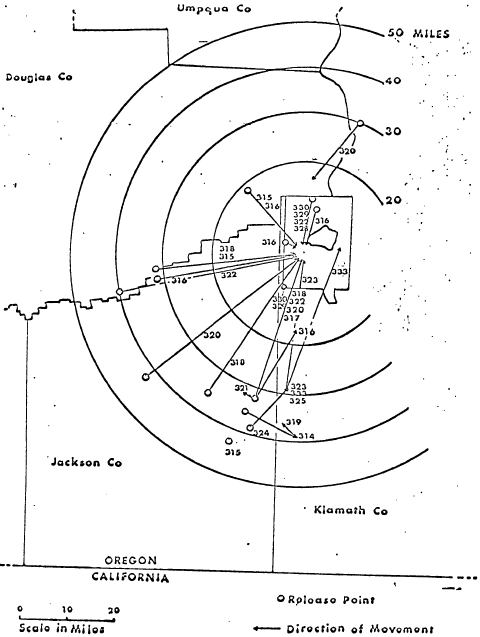 |
| Table 6. Distances and transfer-recovery time intervals for black bears transferred during 1972-73. |
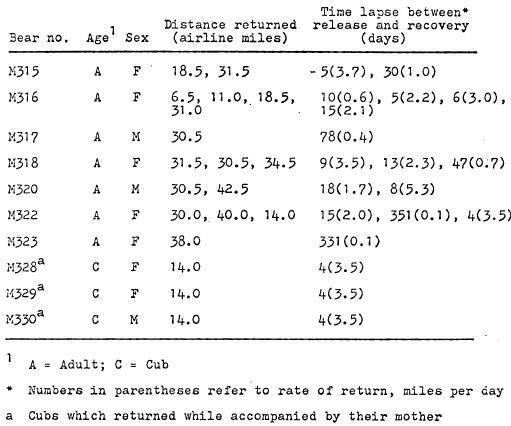 |
In most cases transfer-recovery intervals for returned bears are considered indicative of the speed bears returned to their home ranges (Table 6). The mean rate of return was 2.2 miles per day. Rate of return did not increase successively for bears transferred more than once as would be expected if homing ability became more acute with experience. However, an improved ability to avoid recapture might have masked an increased homing ability.
The relation of distance transferred to likelihood of return is reported in Table 7. Of ten transfers between 6.5 and 19.9 miles eight were unsuccessful. The eight unsuccessful transplants involved three adult females, one of which was accompanied by three cubs. The two transfers for which the status is unknown involved two cubs approximately six months old which were transferred after their mother was destroyed as a nuisance.
All but two of the 13 bears transferred 30 to 39.9 miles a total of 17 times have been recovered. The two bears which have not been sighted or recovered include an adult male and a cub released with its mother. Bears which did not return include M321, M314, M319, M316, M320, and M333. Bear M321 was seriously injured by an automobile and finally shot 14 days after release, five miles from the transplant site. N314 was killed as a nuisance bear 22 days after her release and 10.5 miles from the release site. Her cub, M319, remained in the area and was considered a nuisance until struck and killed by a car 19 days after the death of M314. Y316 and M320 were killed by hunters 18.5 and 16 miles respectively from the original capture points. Both bears were apparently returning when killed. Bear M333 was transferred 38 miles as a cub and recaptured as a yearling approximately eight miles east of its original capture location (Table 4).
| Table 7. Relation of distance transferred to likelihood of return of nuisance black bears transferred from Crater Lake National Park, 1972-73. |
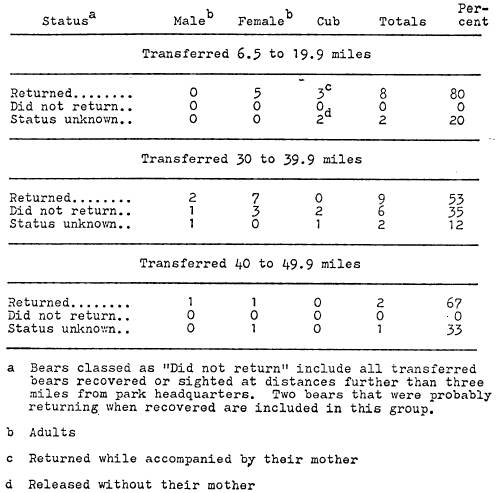 |
Of the three bears transferred more than 40 miles one male and one female have returned while one female was not recovered.
In order to assess the influence of release site on homing transplant locations were ranked according to their quality as bear habitat (Table 8). The ten transfers of less than 20 miles (Fig. 6) may not have removed bears from their area of familiarity and so are not included. The more obvious habitat requirements including cover and feed, especially an immediate food source, were subjectively considered in ranking habitat suitability of transplant sites. By this method original capture sites were considered good to excellent spring-early summer habitat, but only fair on a yearlong basis.
The four bears that apparently re-established themselves in new areas or have not been recovered were released in habitats considered excellent. The one bear released in poor habitat returned at the rate of 5.3 miles per day, the highest rate recorded for all bears. At least seven bears when recovered had returned or were returning to a habitat considered less suitable than the transplant location.
| Table 8. Habitat quality of transplant sites in relation to homing of nuisance black bears transferred 30 to 42.5 miles from Crater Lake National Park.* |
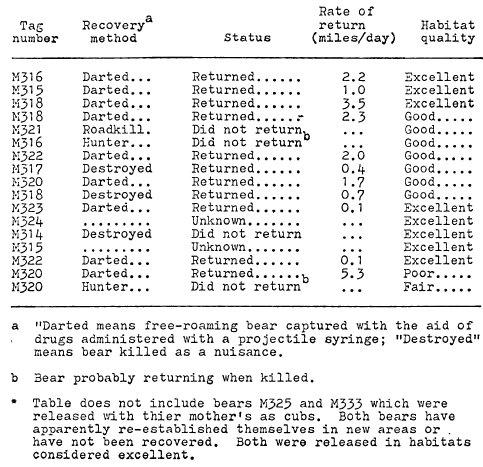 |
Discussion
Recoveries indicate a strong degree of homing for nuisance bears transferred 42.5 miles or less. Erickson and Petrides (1964) reported a home range area for males of 20 square miles and 10 square miles for females. Transfer distances of 30 miles or more were considered sufficient to remove bears from their home ranges or area of familiarity in the Crater Lake study. Yet 76 percent of these bears either returned or traveled in the direction of the original capture site. Only five percent of the bears transferred 30 miles or more traveled away from the capture site. Direction of movement was unknown for 19 percent. Limited data suggest that bears released in poor quality habitat may be more likely to return than those released in good or excellent habitats.
The manner in which bears oriented themselves and returned to their home ranges is unknown. In many instances bears had to travel considerable distances before visual contact could be made with familiar landmarks. The speed with which bears returned and sightings of probable returning bears indicate that little if any random wandering took place after release. The compass direction of transplant locations had no apparent influence on homing. Bears transferred more than once, in different directions, still were able to orient themselves correctly and return. Homing success and the mean rate of return were greater than reported elsewhere (Erickson and Petrides 1964; Sauer et al. 1969). The bold nature and habitual nuisance behavior of the Crater Lake bears combined with intensive recapture efforts are thought responsible.
In addition to indicating an acute homing ability, the quick return of the majority of transferred bears is strongly suggestive of a desire to leave an unfamiliar area occupied by other bears. Antagonistic behavior or its threat may force transplanted bears back onto their home ranges. The type of territorial behavior indicated for black bears by Jonkel and Cowan (1971), where social groups of bears tolerate each other but exclude others, supports this suggestion. Although no evidence was observed on recovered bears to indicate that physical conflict with other bears had occurred, the presence of resident bears could serve as a potential threat of aggression to transplanted bears.
Erickson and Petrides (1964) and Sauer et al. (1969) reported that nuisance bears often continue their nuisance activities when transferred to new areas. Although several such cases were reported during the course of this study only three cases were confirmed. The extent of relocated nuisance activity was exaggerated through the tendency to blame transplanted individuals for all bear problems in the region.
Five transferred bears are known to have been killed outside of the park eliminating possible eventual return. The bold nature and habitual nuisance behavior are considered primary reasons for the vulnerability of these bears. Their lack of familiarity with transplant locations also may have been a contributing factor. Mortality and homing success limited the number of probably successful transplants to 5 of 30 transfers.
Transferring nuisance black bears 42.5 miles or less was not a satisfactory solution to the bear problem at Crater Lake National Park. Homing ability and mortality negated success of the transplant program. Transfer of black bears from one population to another seldom has been seriously questioned. Effects of introducing new genetic material, possible disease transferals, and behavioral interactions with resident bear populations have never been reported or studied. If transplanting is to remain a common practice in national parks and by state game departments further research is needed to assess the impact of transplants on resident bear populations.
RADIO TRACKING STUDIES
Movements And Home Range Sizes
The movements and home range sizes of Crater Lake bears were not adequately determined. Four adult females were fitted with radio collars five times. Only one bear was monitored over a long enough perios to sufficiently describe its home range. Case histories of the four radio instrumented bears follow:
Bear 1,1323 (refer to Figure 7) This bear was an adult female originally captured and ear tagged on 3 August 1972. On 6 August she was again captured and, along with her two cubs p.325 and M333, was transferred 38 miles in a southwesterly direction (Fig. 6). This family group became temporarily established near a resort area approximately ten miles northeast of the transplant site (Fig. 6). They were observed during late August 1972 in this area.
On 3 July 1973 Mv1323 was back in the park and was captured at Rim Village while feeding on garbage. She was not accompanied by her 1972 cubs and was in estrous. M323 was released within the park after her 3 July capture and was live trapped at the Munson dumpsite on 11 July. At this time she was fitted with a radio collar and released. M323 was monitored for 17 days until 28 July when the radio signal became stationary. On 1 August the radio collar was found where the bear had apparently slipped it.
Between 4 July and 28 August M323 was not known to have visited any developed area. By 1 August she began visiting Sleepy Hollow and Rim Village. She fed from garbage cans at these two areas nearly every night until 13 September. Although observed several times, M323 became very wary and quite expert at avoiding capture attempts. She fed from garbage cans only at night, was careful not to allow humans within dart-gun shooting range, would not come to garbage if someone was hiding in a nearby vehicle, would not enter a live trap, and refused to go near a baited foot snare. M’323’s summer activity area (3 July through 13 September) is shown in Figure 7 by locations 1 through 13.
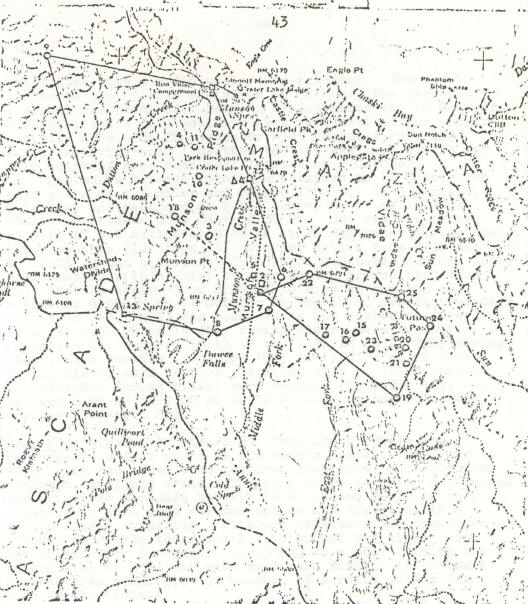 |
 |
| Figure 7. Movements of bear M323 during 1973. |
On 21 September M323 was finally captured in a live trap at the old Munson dumpsite. For the second time this bear was fitted with a radio collar and released. She was monitored for 21 days ending on 12 October, the last date a signal was received. Between 21 September and 12 October, M323 utilized a fall activity area just east of her summer activity area. On 28 September M1323 traveled onto her summer activity area (location 18) but was back within her fall activity area when next located on 2 October.
Distances between locations obtained on 11 successive days averaged 1.1 miles and ranged from 0.1 to 3.9 miles. This bear was recorded as being active on 11 of 19 days monitored between 8:00 AM to 8:30 PM. She was not active at 9:10 AM but active at 9:20 AM on 26 September during cool, clear weather (location 16); was not active from 9:30 AM to 10:05 AM but active at 10:30 AM on 9 October during clear, cold weather with a skift of snow on the ground (location 22); and was active from 8:25 AM to 8:45 AM but was not active at 9:00 AM on 11 October during cold, overcast weather (location 24). M323 was recorded as not active on five days: at 2:30 PM on 14 July during clear, warm weather (location 4); between 10:15 AM to 11:30 AM on 21 July during clear, warm weather (location 10); at 1:50 PM on 28 July during clear, warm weather (location 11); at 12:00 noon on 28 September during clear, warm weather (location 18); and between 8:35 AD: to 9:00 AM on 12 October during cold, wet weather (location 25).
Bear M331 (refer to Figure 8) This adult female was captured in a foot snare at the Munson dumpsite on 7 August 1973. She had never been captured previously nor known to frequent developed areas. The only radio location determined for this bear was made between 10:00 AM and 10:30 AM on 8 August. At this time she was active and traveling in a southeasterly direction. Although extensive and prolonged efforts were made to relocate this animal the signal was not heard after 8 August. On 13 August a bear fitting the description of M331 was seen by a park visitor in the same general area (Fig. 8). No mention of a radio collar was made by the visitor.
Bear M334 (refer to Figure 9) M334 was captured in a foot snare on 24 August 1973. She was released at 10:45 AM on the capture date after being fitted with a radio collar. M334 was active when radio located approximately 0.3 miles north of the capture site on the same afternoon. From 28 August to 4 September the radio signal was stationary. On 4 September the collar was recovered in a moist, grassy area 2.1 miles northwest of the original capture site.
| Figure 8. Movements of bear M331 during 1973. |
 |
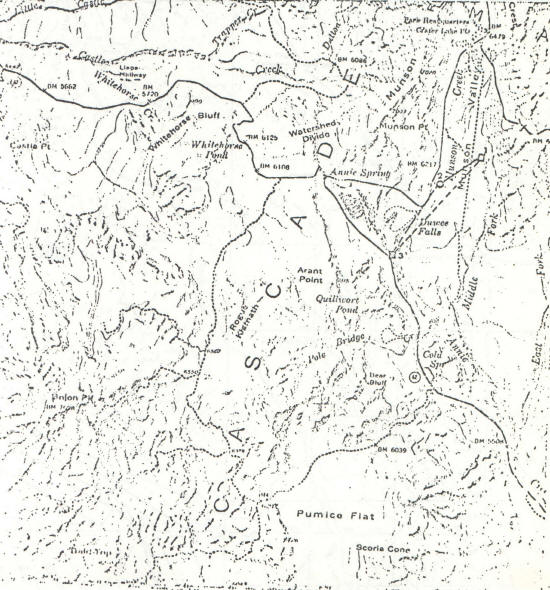 |
| Figure 9. Movements of bear M334 during 1973. |
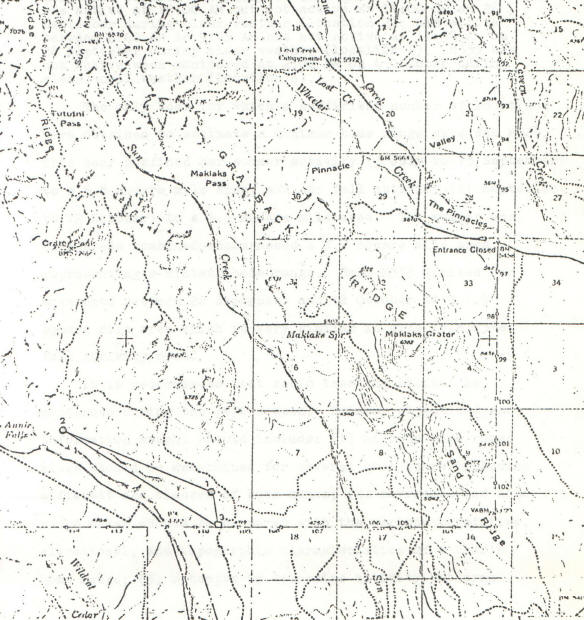 |
Bear M335 (refer to Figure 10) This bear was captured and fitted with a radio collar on 22 September 1973. Nine locations were obtained for M335 between the capture date and 12 October, the last date a signal was received.
Distances between locations obtained on four successive days averaged 0.6 miles and ranged from 0.5 to 0.8 miles. M335 was recorded as being active on six of nine days monitored between the hours of 8:40 AM to 2:00 PM. She was active at 10:00 AM but not active at 11:00 AM on 206 September during clear weather (location 2); and active between 8:40 An to 9:45 AM but not active at 11:30 Ay, on 28 September during clear weather (location 4). M335 was not active when monitored at 2:00 PM on 4 October during clear, cool weather (location 6).
The only bear for which a sufficient number of locations were obtained to estimate a minimum home range size was 1N323. This bear confined her summer activity (3 July to 13 September) to a 5.8 square mile area, and her fall activity (21 September to 12 October) to a 1.5 square mile area. The summer and fall areas combined encompassed a 7.2 square mile area, representing a minimum home range.. Bear M335 limited her movements between 22 September and 12 October to a 1.9 square mile area which is very similar in size to M323’s fall activity area.
It is recommended that radio tracking studies be continued during the 1974 season. Primary objectives and information sought should include: (1) minimum home range sizes should be determined for several more bears including different age classes of both sexes; (2) movements and home range sizes should be compared with the various vegetative, elevation, and topographic characteristics of a bear’s home range; (3) attempts to determine activity patterns
| Figure 10. Movements of bear M335 during 1973. |
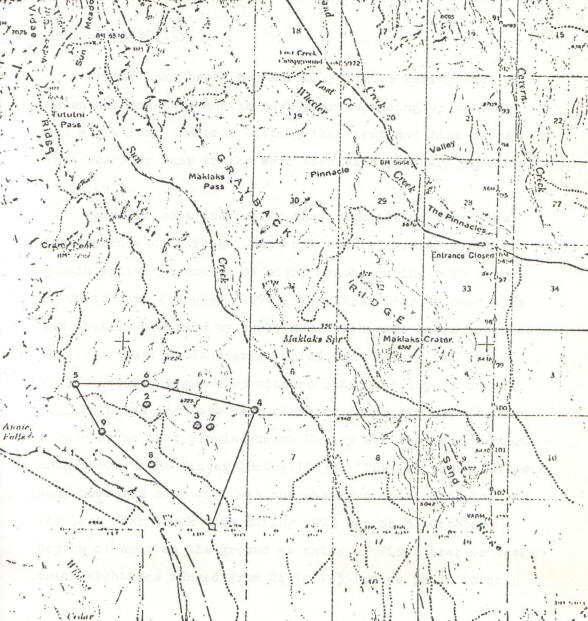 |
POPULATION CHARACTERISTICS
Seasonal Activity
Crater Lake bears are normally active during five to seven and one-half months each year depending on weather and elevation. Records listing the first and last dates when bears or bear tracks were seen each year are presented in Table 9.
There is some indication that, in spite of deep snow, the presence of garbage dumps allowed individual bears to remain active in excess of eight months during some years. Prior to dump closures (1971), the first bear or bear sign woo usually observed by early May, with some bears reported active as late as January. Chief Park Naturalist Bruce, While discussing pre-dump closure bear activity reported “…Old hands indicate that there is often, if not usually, a bear or so that prowls Munson Valley and the headquarters area through the winter (Bruce 1967). The two years following dump closures bear sign was not observed until late May and the last bear track seen during 1973 was on 31 October. Depths of snow on the ground at dates of first bear or bear track sightings ranged from 24 to 163 inches prior to dump closures, was 108 inches in 1972, and only 18 inches in 1973.
| Table 9. Dates when first and last bear or bear sign were observed at Crater Lake National Park.* |
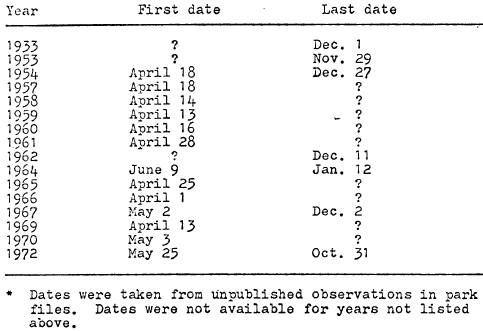 |
Jonkel and Cowan (1971) reported that the Big Creek drainage in Montana has two basic types of black bear habitat. One type is used by bears year round while the other provides supplementary food and cover from mid-July through autumn. It is possible that a similar situation exists at Crater Lake. Within the Canadian and Hudsonian Life Zones snowfall generally limits food availability to June through October. Bears summering in these life zones either move seasonally to and from lower elevations or experience an active season up to two and one-half months shorter than bears occupying ranges within the Transition Zone. Bears are generally active from about May to mid-November in the Transition Zone. Since no bears were radio located after mid-October during 1973 it is unknown whether bears that summered at high elevations denned there also. If the Canadian and Hudsonian Zones are used only seasonally the presence of dumps probably increased the park’s carrying capacity to a limited degree by providing additional year round habitat for a few bears.
Population Estimates
1919 appears to mark the beginning of the nuisance bear at Crater Lake (see Wynd 1930; Walters 1953). The subsequent “presence” of bears was probably due as much to the acclimatization of bears to humans as to an increase in population numbers suggested by Wynd (1930). While an increased food source (the garbage dumps) may have resulted in an increase in bear numbers, Herrero (1969) does not feel it was a substantial increase from pre-park levels.
A summary of minimum population-counts for Crater Lake are presented in Table 10. These counts were made primarily at garbage dumps. Although the figures were reported as minimum counts they are often interpreted as maximum population numbers. Population figures supplied to the public by naturalists range from 20 to 40 bears.
Sixteen different bears were seen during 1972 and 12 bears during 1973. These minimum counts were determined primarily from trapping and are not directly comparable with garbage dump observations. The decreasing number of bears observed at garbage dumps between: 1939 and 1969 (Table 10) does not necessarily represent an actual decrease in total bear numbers. The decreasing number of bears observed probably reflects differences in the degree of effort expended in obtaining counts and differences in the amount of garbage available to bears. Dixon (1944) indicated that high numbers of bears using the Munson Dump from the late 1930’s through 1941 was due to increases in visitor attendance and the consequent tonnage of garbage available to bears. The outbreak of World War II brought a decline in visitor attendance and a reduction in garbage. Although no figures are given by Dixon, numbers of dump bears reportedly declined during the war years. With the surge in visitation following the war, numbers of dump bears increased and then apparently slowly declined until the dumps were closed in 1971.
| Table 10. Minimum population counts of black bears in Crater Lake National Park. |
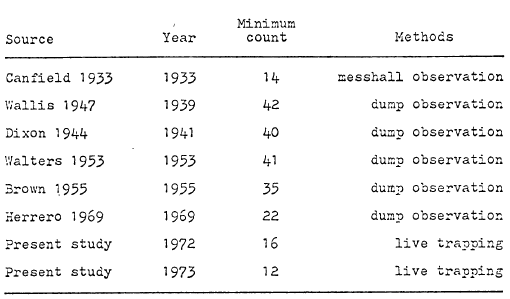 |
Counts made at dumps, and counts made near other developed areas are poor indicators of the park’s bear numbers. Nuisance bears are the bears most frequently observed and their numbers are easily influenced by the park’s fluctuating management practices. In addition to biases resulting from the changing management practices, counts of nuisance bears obtained near developed areas do not take into account approximately 72 percent of the park’s area which is wilderness. For these reasons an alternative method of estimating the bear population was desired.
During 1972 14 nuisance bears were trapped and one unmarked bear was observed within a 2.8 square mile area. This area contained the park’s three major developed areas and sites of both closed dumps (Fig. 11 , Area A). Since the dumps were closed during the fall and winter of 1971, many of the dump bears remained concentrated in this 2.8 square mile area. Thus, density and distribution of the boar Population are not accurately reflected by the one bear per 0.2 square miles computed from the 1972 data.
| Figure 11. Intensive trapping areas in Crater Lake National Park, 1972-73. |
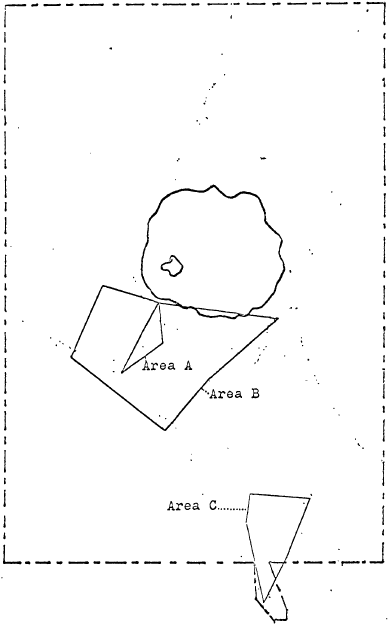 |
In 1973 the major trapping area was increased to encompass 22.9 square miles within the Canadian and Hudsonian Life Zones (Fig. 11, Area B). Eight of the original 14 nuisance bears had been killed by the spring of 1973 and three others were apparently transplanted successfully during 1972. A more natural distribution of bears was achieved by 1973 and nine bears were captured 15 times within the 22.9 square mile area. The one bear per 2.54 square miles derived from the 1973 data is thought to be comparable with natural population densities in untrapped portions of the Canadian and Hudsonian Life Zones.
Habitats within the Transition Life Zone appear to support denser bear numbers than habitats within the Canadian. and Hudsonian Zones. Trapping results on a relatively small area within the Transition Zone (Fig. 11, Area C), indicated a density of one bear per 1.4 square miles during 1973.
Roughly 80 percent of the park’s 229 square miles of land area is within the Canadian and Hudsonian Zones and about 20 percent lies within the Transition Zone. By projecting the computed density of one bear per 2.5 square miles to the area within the Canadian and Hudsonian Zones a total of 72 bears is obtained. Similarly, the Transition bone, at one bear per 1.4 square miles, was estimated to support 40 bears. Thus, the total estimate for the Park’s bear population was 112 bears in 1973. If the Canadian and Hudsonian Zones provide only seasonal range for bears which live predominately in the Transition Zone, this estimate may be high (see P. 51).
Twelve and four bears were removed from the park population by various means in 1972 and 1973 respectively. Assuming a population of 112 bears in the spring of 1973, a natural mortality:natality ratio of zero during 1972-73, and equal emigration and immigration, the spring 1972 population should have been about 124 bears and the fall 1973 population 108 bears. This is a 13 percent decrease in population over the two years.
The removal of 15 nuisance bears has markedly reduced the opportunity for visitors to observe bears (nuisance bears are more easily observed than wild bears). The reduction in the number of different bears sighted during 1972 (Table 10) is often inferred to indicate a significant reduction in the total population. Using estimated population figures, nuisance bears comprised about 11 and 3 percent of the population in 1972 and 1973 respectively. So, while numbers of nuisance bears were reduced by nearly 90 percent, the total population decreased only an estimated 13 percent.
The available data indicate that the natural carrying capacity (K) of the park approximates 100 to 125 bears. Prior to 1972 the presence of dumps probably created a somewhat higher but unknown level of K. Following- dump closures some bears apparently dispersed to surrounding areas within and outside of the park, while at least ten bears and their offspring remained concentrated near the dumpsites and became nuisances. Nearly all of these nuisance bears were eliminated from the park population by the fall of 1973. Their removal has resulted in a population decrease (estimated 13 percent) but remains within the estimated range of K. Since nearly all nuisance bears have been eliminated, and assuming that corrective management steps will be taken to reduce the need for bear control, the population should remain near its present level or increase slightly.
Reproduction
Little data have been accumulated concerning reproductive characteristics of Crater Lake bears. The breeding season for black bears is generally recognized as June through mid-July, although it is not uncommon to find individuals in estrous through August (Bray and Barnes 1967). No data are available to indicate that the breeding season for Crater Lake bears is any different. Table 11 lists dates and the reproductive status of adult female black
| Table 11. Reproductive status of female black bears I handled at Crater Lake National Park, 1972-73. |
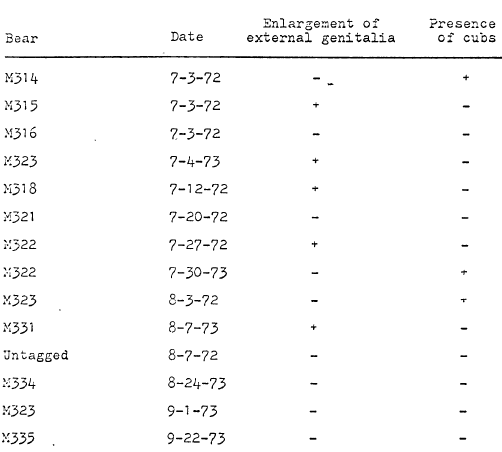 |
bears handled at Crater Lake during 1972 and 1973. In 1972, females M315 and M318 were accompanied by larger bears, presumably males, on 11 July and 12 July respectively. Three litters were handled during the study period. Two litters each contained two cubs mothered by M323 and M314. The third litter of three cubs was mothered by M322. A summary of litter sizes reported from Crater Lake is presented in Table 12.
Sport Hunting
The effect of sport hunting on the Crater Lake population is poorly understood but does not appear to limit bear numbers. Home ranges of some bears overlap onto surrounding forests where they are legally hunted from 1 August through 31 December. Hunting pressure is not heavy.
During 1972-73 I talked with three different hunting parties that used hounds and Periodically hunted the area south of the south boundary. One group reported that members of their party killed five bears within a five mile strip of the south boundary during the 1972 bear season. The same group had treed bears, none of which were killed, nine times in this same area between April and August of 1973. None of the groups interviewed indicated a decrease in bear numbers or difficulty in location bear sign.
| Table 12. Litter sizes of black bears at Crater Lake National Park. |
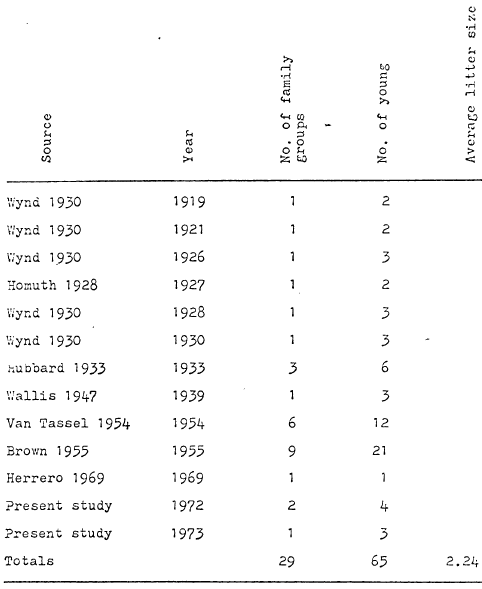 |
Parasites, Diseases, And Abnormalities
No diseased bears were found in Crater Lake National Park. Open garbage dumps may provide a favorable environment for the transmission of Trichinella spiralis to wildlife (Zimmermann 1970). One tongue sample was collected to be used in testing for trichinosis but the results are not yet available. Although all captured bears were examined, no ticks, fleas, or lice were observed. No attempt was made to determine species or incidence of internal parasites other than T. spiralis.
The majority of nuisance bears had one or more broken canines and one bear had lost two lower incisors. In contrast, only one of the six bears captured in wilderness situations had a broken canine. Bears were not examined to determine the presence or absence of dental caries.
Although not related to the general health of bears, one yearling female examined had only five teats instead of the normal count of six. The right lower pectoral teat was missing, apparently due to a genetical defect since there was no sign of injury to the area. Burton (personal conversation 1973) reported examining several bears in northern California which had only five teats.
PHYSICAL CHARACTERISTICS
Weights And Measurements
Regrettably, no weights or measurements were obtained brown bears prior to dump closures. Therefore, correlations can not be drawn concerning gross physical condition as related to food availability at the garbage dumps.
Bears captured during 1972-73 appeared to be in good physical condition. Individual weights and measurements of bears captured are shown in Table 13. Average summer weights of Crater Lake bears are reported according to sex -and age class in Table 14. Although the sample size is small, Crater Lake bears appear to be as large as bears reported elsewhere.
In northern California, Burton (1972), found the average weight of 12 adult females to be 124 lb. The average weight of 76 adult females trapped in Montana was 125 lb (Jonkel and Cowan 1971). Stickley (19061) gives the average adult female weight of Virginia bears as 119 lb. Harlow (1961) reported average adult female weights for Florida as 189 lb, 183 lb for New Hampshire, and 200 lb for New York. Most of Harlow’s weights were taken in in the fall.
| Table 13. Individual weights and measurements of black bears handled during 1972 and 1973. |
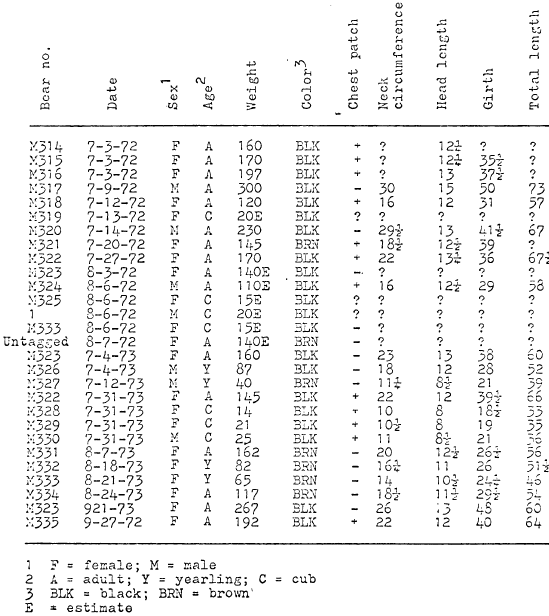 |
| Table 14. Average summer weights of Crater Lane black bears handled during 1972 and 1973. |
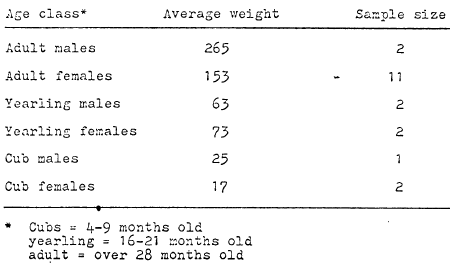 |
Average weights reported for adult males in other areas include 206 lb in California (Burton 1972), a July-August average of 1 88 lb in Montana (Jonkel and Cowan 1971), 157 lb in Virginia (Stickley 1961), 304 in Florida, 203 in New Hampshire, and 324 in New York (Harlow 1961). Here again, Harlow’s weights are mostly from the fall.
Jonkel and Cowan (1971) found that black bears gained weight slowly or lost weight during the spring and early summer, and that from mid-July until October bears gained weight rapidly. During late summer and autumn they found that 14 bears gained an average of 0.84 lb per day, with one adult female gaining 1.55 lb per day for 22 days. These bears were foraging on natural feeds including many kinds of fruits.
Differences between summer and fall weights were determine for two Crater Lake bears. Bear M323 gained 107 lb or 1.35 lb per day over a 79 day period between July and late September. An examination of Table 13 gives an indication a. how this weight was distributed. Measurements of total length and head length remained unchanged while head circumference increased by one-half inch, neck circumference by 3 inches, and girth by 10 inches. The other bear for which both summer and fall weights are available is M320. This bear weighed 230 lb when .first captured on July 14. When killed by a hunter outside of the cark on 10 September, M320 reportedly weighed 350 lb. If the weight given by the hunter is accurate, this bear gained 120 lb in 58 days or 2.07 lb Per day. Both M323 and M320 were supplementing their natural diet with garbage during the periods of weight gains.
M322 was the only bear known to loose weight during the study period. This female lost 25 lb between captures on 27 July 1972 and 31 July 1973. When captured during 1973, M322 was accompanied by three cubs which probably explains the reason for a weight loss. In spite of losing 25 lb, M322 appeared to be in very good condition.
Hide Condition
Hide condition was rated according to suitability for tanning and potential trophy value. All coats examined were rated as fair or poor during July. Early in July some bears had long dense coats that appeared to be in excellent condition. Closer examination reveled that hair was loose and could be pulled out by handfulls. Hide condition remained poor through the first half of August but started improving thereafter. During the second half of August a few animals were rated as fair and by mid-September several bears had good coats. Both bears captured after mid-September had excellent coats.
Coloration
Coat color was ranked as either black or brown. Black animals which had reddish or brownish tints or a lighter colored underfur, were still classed as black due to their overall appearance. Of the 24 bears observed 6 were brown, 17 were black, and 1 bear was classed as black in 1972 and brown in 1973. Table 15 presents these findings with those from other sources.
Bear M333 was captured as a cub in 1972. The cub’s color appeared dull black although some indication of an extremely dark brownish tint was evident. When captured in September of 1973, IM333 was cinnamon in color on the shoulders, neck, and down the back. On the sides and legs the cinnamon color shaded into a dark brown. The degree of fading due to normal wear and exposure to sunlight is unknown but probably contributed to this color change. Miller (1955) reported an incident involving a change in color phase of a two year old black bear. However, in Miller’s case the bear molted from cinnamon to black rather than from dull black to a lighter color.
Little information is available concerning the frequency of the white chest patch in black bears. Of 21 bears where this information was noted, 11 had a chest patch while 10 did not. Size and shape of the chest patches varied greatly.
| Table 15. Color variation among black bears at Crater Lake National Park. |
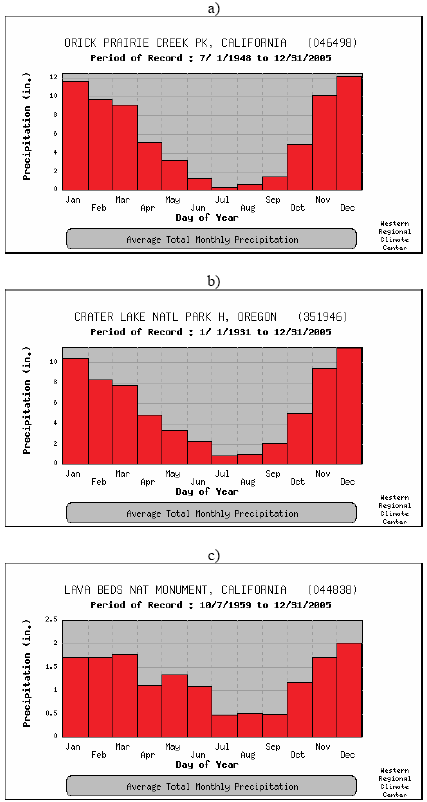 |
